
Trakai Island Castle
Encyclopedia
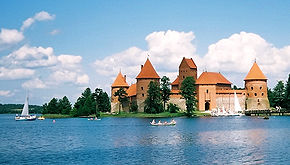
Island castle
The island castle is a variation of the water castle. It is distinguished by its location on an artificial or natural island. It is a typical lowland castle....
located in Trakai
Trakai
Trakai is a historic city and lake resort in Lithuania. It lies 28 km west of Vilnius, the capital of Lithuania. Because of its proximity to Vilnius, Trakai is a popular tourist destination. Trakai is the administrative centre of Trakai district municipality. The town covers 11.52 km2 of...
, Lithuania
Lithuania
Lithuania , officially the Republic of Lithuania is a country in Northern Europe, the biggest of the three Baltic states. It is situated along the southeastern shore of the Baltic Sea, whereby to the west lie Sweden and Denmark...
on an island in Lake Galvė
Lake Galve
Lake Galvė is a lake in Trakai Lithuania. It has 21 islands, and one of them houses Trakai Island Castle. Trakai Peninsula Castle is located on its southern shore. There are ruins of the little Orthodox church in Bažnytėlė Island. The lake and most of the other lakes surrounding the castle and...
. The castle is sometimes referred to as "Little Marienburg
Malbork Castle
The Marienburg Castle in Malbork is by area the largest castle in the world. It was built in Prussia by the Teutonic Knights, a German Roman Catholic religious order of crusaders, in a form of an Ordensburg fortress. The Order named it Marienburg...
". The construction of the stone castle was begun in the 14th century by Kęstutis
Kestutis
Kęstutis was monarch of medieval Lithuania. He was the Duke of Trakai and governed the Grand Duchy of Lithuania, 1342–82, together with his brother Algirdas , and with his nephew Jogaila...
, and around 1409 major works were completed by his son Vytautas the Great
Vytautas the Great
Vytautas ; styled "the Great" from the 15th century onwards; c. 1350 October 27, 1430) was one of the most famous rulers of medieval Lithuania. Vytautas was the ruler of the Grand Duchy of Lithuania which chiefly encompassed the Lithuanians and Ruthenians...
, who died in this castle in 1430. Trakai was one of the main centres of the Grand Duchy of Lithuania
Grand Duchy of Lithuania
The Grand Duchy of Lithuania was a European state from the 12th /13th century until 1569 and then as a constituent part of Polish-Lithuanian Commonwealth until 1791 when Constitution of May 3, 1791 abolished it in favor of unitary state. It was founded by the Lithuanians, one of the polytheistic...
and the castle held great strategic importance.
First Phase
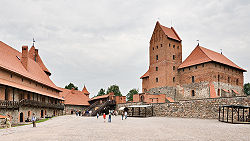
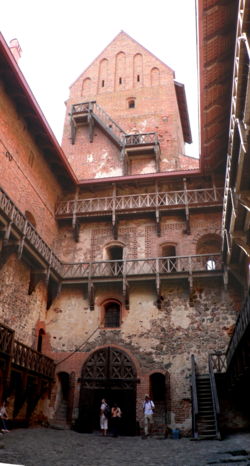
Kestutis
Kęstutis was monarch of medieval Lithuania. He was the Duke of Trakai and governed the Grand Duchy of Lithuania, 1342–82, together with his brother Algirdas , and with his nephew Jogaila...
. The construction of Trakai Island Castle was related to the expansion and strengthening of the Trakai Peninsula Castle
Trakai Peninsula Castle
Trakai Peninsula Castle is one of the castles in Trakai, Lithuania. It is located on a peninsula between southern Lake Galvė and Lake Luka. Built around 1350–1377 by Kęstutis, Duke of Trakai, it was an important defensive structure protecting Trakai and Vilnius, capital of the Grand Duchy of...
. Kęstutis moved his main residence and his treasury to the Island Castle.
The castle suffered major damage during an attack by the Teutonic Knights
Teutonic Knights
The Order of Brothers of the German House of Saint Mary in Jerusalem , commonly the Teutonic Order , is a German medieval military order, in modern times a purely religious Catholic order...
in 1377. After the assassination of Kęstutis, a power struggle between Jogaila
Jogaila
Jogaila, later 'He is known under a number of names: ; ; . See also: Jogaila : names and titles. was Grand Duke of Lithuania , king consort of Kingdom of Poland , and sole King of Poland . He ruled in Lithuania from 1377, at first with his uncle Kęstutis...
and Vytautas the Great
Vytautas the Great
Vytautas ; styled "the Great" from the 15th century onwards; c. 1350 October 27, 1430) was one of the most famous rulers of medieval Lithuania. Vytautas was the ruler of the Grand Duchy of Lithuania which chiefly encompassed the Lithuanians and Ruthenians...
for the title of Grand Duke of Lithuania
Grand Duchy of Lithuania
The Grand Duchy of Lithuania was a European state from the 12th /13th century until 1569 and then as a constituent part of Polish-Lithuanian Commonwealth until 1791 when Constitution of May 3, 1791 abolished it in favor of unitary state. It was founded by the Lithuanians, one of the polytheistic...
began. The castle was besieged by both sides. Soon after the reconciliation between Jogaila and Vytautas, the second phase of construction started and continued until 1409. This phase is regarded as the major development in the history of the castle. Apparently, during the truce with the Teutonic Order, the construction works were supervised by the Order's stonemason Radike, four years before the Battle of Grunwald
Battle of Grunwald
The Battle of Grunwald or 1st Battle of Tannenberg was fought on 15 July 1410, during the Polish–Lithuanian–Teutonic War. The alliance of the Kingdom of Poland and the Grand Duchy of Lithuania, led respectively by King Jogaila and Grand Duke Vytautas , decisively defeated the Teutonic Knights, led...
.
Second Phase
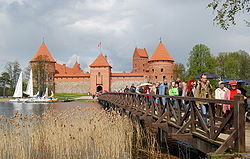
Keep
A keep is a type of fortified tower built within castles during the Middle Ages by European nobility. Scholars have debated the scope of the word keep, but usually consider it to refer to large towers in castles that were fortified residences, used as a refuge of last resort should the rest of the...
was built. The donjon had movable gates which separated the palace from the forecastle. The donjon was used for several functions; besides serving as another defensive structure, it had a chapel and living quarters. It was linked to the multistory Ducal Palace, which had an inner yard. The inner yard had wooden galleries, which ran around the inner wall; these galleries were used to access various support facilities without going inside the palace itself.
The entire southern wing of the southern palace was used for the Ducal Hall. This hall was around 10 x 21 metres in size, and only the Upper Palace in the Vilnius Castle Complex
Vilnius Castle Complex
The Vilnius Castle Complex , is a group of cultural, and historic structures on the left bank of the Neris River, near its confluence with the Vilnia River, in Vilnius, Lithuania. The buildings, which evolved between the 10th and 18th centuries, were one of Lithuania's major defensive...
managed to surpass it. The Ducal Hall has preserved some of its original décor.
The principal construction material was so-called red Gothic bricks. Stone blocks were used only in the foundations and the upper parts of buildings, towers and walls. The castle was decorated in a variety of ways, including glazed roof tiling, burned bricks, and stained glass windows. Its overall style after the second construction phase could be described as Gothic
Gothic architecture
Gothic architecture is a style of architecture that flourished during the high and late medieval period. It evolved from Romanesque architecture and was succeeded by Renaissance architecture....
with some Romanesque
Romanesque architecture
Romanesque architecture is an architectural style of Medieval Europe characterised by semi-circular arches. There is no consensus for the beginning date of the Romanesque architecture, with proposals ranging from the 6th to the 10th century. It developed in the 12th century into the Gothic style,...
features.
Third Phase
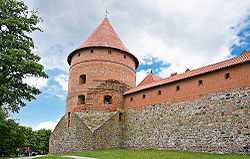
Falling into Disrepair
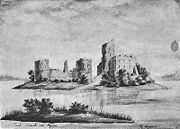
Battle of Grunwald
The Battle of Grunwald or 1st Battle of Tannenberg was fought on 15 July 1410, during the Polish–Lithuanian–Teutonic War. The alliance of the Kingdom of Poland and the Grand Duchy of Lithuania, led respectively by King Jogaila and Grand Duke Vytautas , decisively defeated the Teutonic Knights, led...
, when the chief enemy of the Grand Duchy of Lithuania
Grand Duchy of Lithuania
The Grand Duchy of Lithuania was a European state from the 12th /13th century until 1569 and then as a constituent part of Polish-Lithuanian Commonwealth until 1791 when Constitution of May 3, 1791 abolished it in favor of unitary state. It was founded by the Lithuanians, one of the polytheistic...
was defeated by the Lithuanian-Polish army. The castle was transformed into a residence and newly decorated from the inside. New frescos were painted on its walls, which have been partially preserved. Foreign emissaries were welcomed in the Ducal Palace. It is known that Jogaila visited the castle thirteen times between 1413 and 1430. In 1414, the Flemish
Flemish people
The Flemings or Flemish are the Dutch-speaking inhabitants of Belgium, where they are mostly found in the northern region of Flanders. They are one of two principal cultural-linguistic groups in Belgium, the other being the French-speaking Walloons...
traveler Guillebert de Lannoy
Guillebert de Lannoy
Guillebert de Lannoy , was a Flemish traveler and diplomat, chamberlain to the duke of Burgundy, governor of the fort of Sluys, and a knight of the Golden Fleece....
described the castle in these words:
Grand Duke Vytautas the Great died in the castle without being crowned as King of Lithuania in 1430. During the rule of Sigismund Augustus, the castle was redecorated in a Renaissance
Renaissance
The Renaissance was a cultural movement that spanned roughly the 14th to the 17th century, beginning in Italy in the Late Middle Ages and later spreading to the rest of Europe. The term is also used more loosely to refer to the historical era, but since the changes of the Renaissance were not...
style, and it served as the royal summer residence for a short period of time. Lithuanian Metrica
Lithuanian Metrica
The Lithuanian Metrica or the Metrica of the Grand Duchy of Lithuania is a collection of the 14–18th century legal documents of the Chancellery of the Grand Duchy of Lithuania...
was kept in the castle until 1511. Later the castle served as a prison. During the wars with Muscovy in the 17th century, the castle was damaged and was not reconstructed again. It gradually fell into disrepair.
Reconstruction
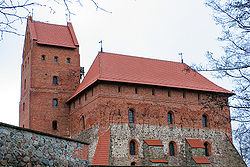
World War I
World War I , which was predominantly called the World War or the Great War from its occurrence until 1939, and the First World War or World War I thereafter, was a major war centred in Europe that began on 28 July 1914 and lasted until 11 November 1918...
, Germans brought in their specialists, who made several attempts to restore the castle. In 1935-1941 parts of the Ducal Palace walls were strengthened, and the southeastern forecastle tower was rebuilt, including sections of its walls. Lithuania
Lithuania
Lithuania , officially the Republic of Lithuania is a country in Northern Europe, the biggest of the three Baltic states. It is situated along the southeastern shore of the Baltic Sea, whereby to the west lie Sweden and Denmark...
n and Polish
Poland
Poland , officially the Republic of Poland , is a country in Central Europe bordered by Germany to the west; the Czech Republic and Slovakia to the south; Ukraine, Belarus and Lithuania to the east; and the Baltic Sea and Kaliningrad Oblast, a Russian exclave, to the north...
preservationists worked on the project, but the work stopped when the war gained in intensity. After World War II
World War II
World War II, or the Second World War , was a global conflict lasting from 1939 to 1945, involving most of the world's nations—including all of the great powers—eventually forming two opposing military alliances: the Allies and the Axis...
, a major reconstruction project was begun in 1946; active work started in 1951-1952. The major portion of the reconstruction was finished in 1961. The castle was reconstructed in a 15th century style.
Trakai Island Castle is now a major tourist attraction.
See also
- Trakai Castle (video)
- Trakai CastleTrakai CastleThe term Trakai Castle might refer to three separate castles in Lithuania:* Trakai Island Castle, located on an island in Lake Galvė* Trakai Peninsula Castle, located on a peninsula of Lake Galvė...
- Trakai Peninsula CastleTrakai Peninsula CastleTrakai Peninsula Castle is one of the castles in Trakai, Lithuania. It is located on a peninsula between southern Lake Galvė and Lake Luka. Built around 1350–1377 by Kęstutis, Duke of Trakai, it was an important defensive structure protecting Trakai and Vilnius, capital of the Grand Duchy of...
- Old Trakai CastleOld Trakai CastleSenieji Trakai Castle was a castle in Senieji Trakai in Lithuania.The first enclosure type brick castle was built by Grand Duke Gediminas, who transferred the capital of Lithuania from Kernavė to Trakai before 1321...
- List of castles in Lithuania

